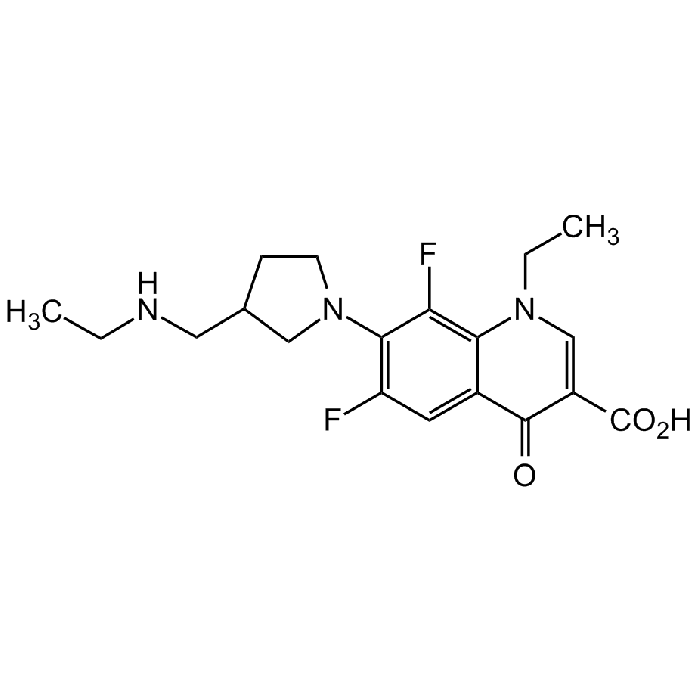Cookie Policy: This site uses cookies to improve your experience. You can find out more about our use of cookies in our Privacy Policy. By continuing to browse this site you agree to our use of cookies.
AdipoGen Life Sciences
Merafloxacin
As low as
100
CHF
CHF 100.00
In stock
Only %1 left
AG-CR1-3756-M0055 mgCHF 100.00
AG-CR1-3756-M02525 mgCHF 400.00

| Product Details | |
|---|---|
| Synonyms | CI-934; PD 114843; 1-Ethyl-7-(3-((ethylamino)methyl)-1-pyrrolidinyl)-6,8-difluoro-1,4-dihydro-4-oxo-3-quinolinecarboxylic acid |
| Product Type | Chemical |
| Properties | |
| Formula |
C19H23F2N3O3 |
| MW | 379.4 |
| CAS | 91188-00-0 |
| Purity Chemicals | ≥98% (NMR) |
| Appearance | White to off-white solid. |
| Solubility | Soluble in DMSO. |
| Identity | Determined by 1H-NMR |
| InChi Key | BAYYCLWCHFVRLV-UHFFFAOYSA-N |
| Smiles | O=C1C2=CC(F)=C(N3CCC(CNCC)C3)C(F)=C2N(CC)C=C1C(O)=O |
| Shipping and Handling | |
| Shipping | AMBIENT |
| Short Term Storage | +4°C |
| Long Term Storage | -20°C |
| Handling Advice | Keep cool and dry. |
| Use/Stability | Stable for at least 2 years after receipt when stored at -20°C. |
| Documents | |
| MSDS |
 Download PDF Download PDF |
| Product Specification Sheet | |
| Datasheet |
 Download PDF Download PDF |
Description
- Merafloxacin is a fluoroquinolone broad-spectrum antibacterial compound. It is an inhibitor of bacterial DNA gyrase and Type II DNA topoisomerase. It demonstrated excellent activity against Gram-positive organisms and less potent activity against Gram-negative bacteria.
- Merafloxacin is a programmed -1 ribosomal frameshifting (-1 PRF) inhibitor of SARS-CoV-2. Frameshift inhibition by merafloxacin is robust to mutations within the pseudoknot region and is similarly effective on -1 PRF of other betacoronaviruses and blocks SARS-CoV-2 replication in Vero E6 cells. The compound reduced viral levels in infected African green monkey VeroE6 cells in a concentration-dependent manner. Merafloxacin showed no cellular toxicity and resulted in a 3 to 4 orders of magnitude reduction of SARS-CoV-2 titer, with IC50 of 4.3 μΜ. This compound provides a starting point for high-throughput screening for frameshifting inhibitors as a viable target for therapeutic intervention against SARS-CoV-2.
Product References
- In vitro activity of CI-934, a quinolone carboxylic acid active against gram-positive and -negative bacteria: M.A. Cohen, et al.; Antimicrob. Agents Chemother. 28, 766 (1985)
- Discrepancy between the antibacterial activities and the inhibitory effects on Micrococcus luteus DNA gyrase of 13 quinolones: K.P. Fu, et al.; Chemotherapy 32, 494 (1986)
- In vitro activity of CI-934 and other antimicrobial agents against gram-positive and gram-negative bacteria: R.P. Smith, et al.; Clin. Ther. 9, 106 (1986)
- In vitro assessment of CI-934-a new quinolone derivative: R. Finch, et al.; Chemioterapia 5, 368 (1986)
- Inhibitory effects of quinolones on DNA gyrase of Escherichia coli and topoisomerase II of fetal calf thymus: K. Hoshino, et al.; Antimicrob. Agents Chemother. 33, 1816 (1989)
- Restriction of SARS-CoV-2 Replication by Targeting Programmed -1 Ribosomal Frameshifting In Vitro: Y. Sun, et al.; Preprint (2020)
- Programmed −1 Ribosomal Frameshifting in coronaviruses: A therapeutic target: J.A. Kelly, et al.; Virology 554, 75 (2021)
- Structural basis of ribosomal frameshifting during translation of the SARS-CoV-2 RNA genome: P.R. Bhatt, et al.; Science (Epub ahead of print) (2021)





